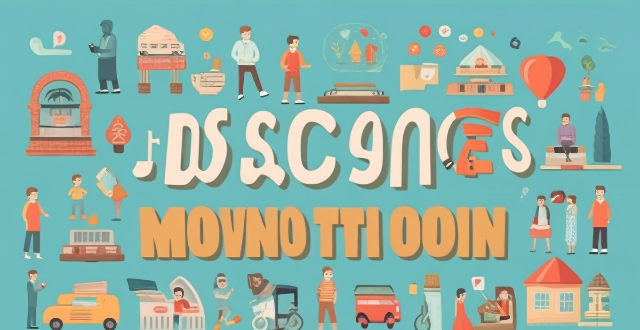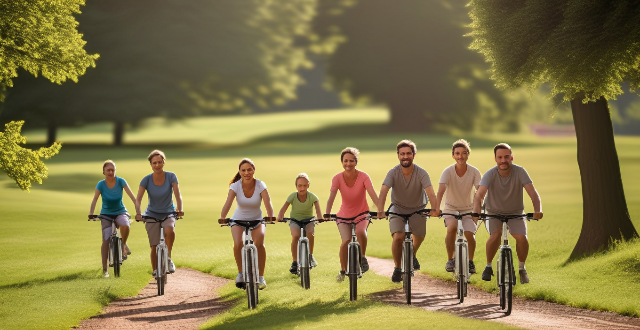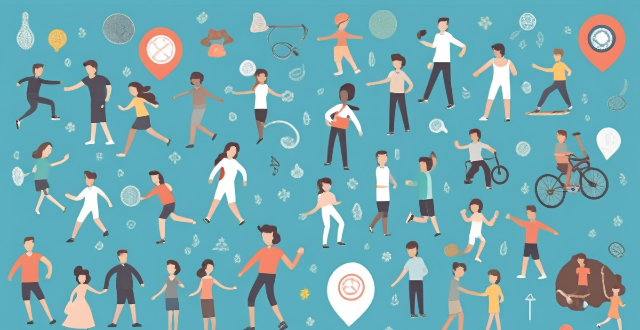Social Influence

How does social media influence consumer behavior ?
Social media has transformed consumer behavior by increasing brand awareness, influencing purchasing habits, and changing perceptions of brands. It enables consumers to compare products, share feedback, and engage with companies directly. Social media also plays a crucial role in product development by providing insights into consumer needs and preferences. Companies can foster customer loyalty through engagement and exclusive deals on these platforms. The rise of social commerce allows for direct purchases within apps and live streaming sales events. Personalization and targeted marketing, including influencer collaborations, further impact consumer choices. Overall, social media's influence on consumer behavior is significant and continues to evolve with technological advancements.

How can celebrities use their influence for social change ?
Celebrities have a unique opportunity to use their influence for social change. They can leverage their fame and platform to bring attention to important issues, inspire their fans to take action, and make a positive impact on the world. Celebrities can use their platform to raise awareness about important social issues, inspire their fans to take action by sharing their own experiences and stories related to social issues, partner with organizations that are working towards social change, use their talents and skills to support social change initiatives, and advocate for policy changes at the local, national, or international level. By doing so, celebrities can help shape laws and regulations that promote social justice and equality.

How do competitive sports influence social development and teamwork skills ?
Competitive sports play a significant role in shaping individuals' social development and enhancing their teamwork skills. This essay explores the various ways in which competitive sports influence these aspects of personal growth, including increased social interaction, building confidence and self-esteem, learning to deal with success and failure, collaboration, communication skills, leadership development, and responsibility and accountability. These skills are not only valuable in sports but also transferable to various aspects of life, making competitive sports an essential component of personal growth and development.

How has social media influenced environmental awareness campaigns ?
The text discusses how social media has revolutionized communication and information sharing, particularly in the context of environmental awareness campaigns. It outlines various ways in which social media has impacted these campaigns, including increased visibility, interactivity, accessibility, influence of celebrities and influencers, real-time updates, and crowdsourcing and fundraising opportunities. The text concludes that social media is an essential tool for promoting environmental causes and will likely continue to play a significant role in shaping our understanding of the environment and inspiring action.

How do celebrities influence the trends in sports fashion ?
Celebrities significantly impact sports fashion trends by setting styles, partnering with brands, using social media influence, promoting healthy habits, and participating in sports events. This influences consumer choices and shapes the market for sportswear.

What are the benefits of using influencer marketing in social media ?
Influencer marketing in social media offers benefits such as increased brand awareness, targeted audience engagement, cost-effective marketing, authentic content creation, accelerated growth opportunities, strategic placement and promotion, and complementary creative direction. By leveraging influencers with a significant following, companies can reach new audiences and enhance their credibility. Influencers often cater to specific niches, allowing for highly targeted demographic engagement. They create user-generated content that resonates more with consumers than polished advertisements. Collaborations with influencers can lead to long-term partnerships and co-marketing opportunities. Influencers can promote brands across multiple social media platforms and provide analytics on their campaigns. They bring fresh perspectives to a brand's creative direction and can keep it relevant by aligning with current trends. It is essential to choose the right influencers and manage these relationships effectively to ensure success in influencer marketing endeavors.

How do celebrities influence fashion trends and beauty standards ?
Celebrities significantly influence fashion trends and beauty standards through their endorsements, red carpet appearances, social media presence, and collaborations with designers. They set trends by making innovative style choices and promoting self-care and wellness. However, their influence is not without controversy, as some argue it leads to unrealistic beauty standards and cultural appropriation.

How does sports influence literary creation ?
The influence of sports on literary creation is explored in this article. Sports have provided writers with motivation and inspiration, introduced themes and characters, contributed to realism and atmosphere, and served as a vehicle for social commentary. Examples from various literary works are given to illustrate these points.

How can investors influence corporate behavior towards reducing carbon emissions ?
Investors can influence corporate behavior towards reducing carbon emissions by using their financial power and influence. They can do this through shareholder engagement, collaborative engagement, financial incentives, public advocacy, and strategic dialogue. By employing these strategies, investors not only promote corporate responsibility but also pave the way for a more sustainable future.

What are the positive effects of celebrity influence on society ?
Celebrities wield significant influence that extends beyond their areas of expertise, and this influence can have both positive and negative impacts on society. The positive effects include raising awareness on important issues, promoting education, cultural exchange, economic growth, sustainable living, fashion trends, and driving social change through activism. Celebrities can use their platforms to bring attention to global concerns, promote healthy lifestyles, encourage mental health discussions, support literacy programs, inspire STEM pursuits, showcase cultural diversity, boost local businesses, foster entrepreneurship, advocate for eco-friendly practices, diversify beauty standards, engage in political conversations, and strengthen community bonds. However, with great influence comes great responsibility; celebrities should strive to use their platform thoughtfully and constructively for the betterment of society.

Can celebrity influence be harnessed for educational purposes or promoting literacy ?
This article explores the potential of leveraging celebrity influence for educational purposes and promoting literacy. It outlines how celebrities can advocate for education, serve as role models, and directly involve themselves in educational initiatives. The text also suggests ways celebrities can promote literacy, such as hosting reading challenges, authoring children's books, and endorsing online courses. Overall, the article concludes that celebrity influence can be a powerful tool for fostering a culture of learning and literacy.

How do sports figures use their influence to promote charitable causes ?
Athletes and sports figures leverage their fame, influence, and reach to promote charitable causes, making a difference in various aspects of humanitarian work. They use their platform to educate the public about issues that need attention, share personal stories related to the cause, organize matches or events where proceeds go towards a specific charity, donate prize money from competitions, create special merchandise with a portion of sales going to support a charity, volunteer time with organizations, give back to local communities by participating in local events or contributing to community projects, meet with legislators to discuss policies that could positively impact their supported causes, engage in lobbying efforts, partner with established charitable organizations, and team up for endorsement deals that include clauses where a portion of earnings goes towards a specific charity or is used to support a social initiative.

How does exercise influence social skills in children ?
Exercise plays a crucial role in shaping children's social skills by enhancing communication, empathy, emotional intelligence, resilience, problem-solving abilities, healthy risk-taking, and leadership skills. Physical activity helps children build self-confidence, promotes teamwork, develops empathy, enhances emotional intelligence, increases resilience, enhances problem-solving abilities, encourages healthy risk-taking, and fosters leadership skills. These skills are essential for establishing positive relationships with peers and contributing to their communities. Therefore, it is imperative to encourage children to engage in regular exercise to support their overall development and success in life.

How does sports culture influence fashion trends and consumer behavior ?
The intersection of sports culture and fashion trends is a dynamic relationship that significantly influences consumer behavior. As lifestyles become more active and health-conscious, the impact of sports culture on fashion choices extends beyond athleticwear to high fashion and streetwear. Athleisure, collaborations between sports and luxury brands, and the influence of sports icons have redefined what's considered stylish and desirable. Consumers increasingly prioritize comfort, functionality, and sustainability in their clothing choices, reflecting a shift towards durable, high-quality sports apparel over disposable fast fashion items. The rise of fitness influencers on social media platforms further drives this trend, shaping public perception of workout gear. Overall, the sports-fashion nexus is expected to continue growing, reflecting societal values of health and wellness.

How do celebrities influence public opinion on environmental issues ?
Celebrities significantly influence public opinion on environmental issues by raising awareness, influencing behaviors, funding initiatives, advocating for policy changes, utilizing social media, and collaborating with organizations. They highlight key environmental issues, participate in campaigns, set eco-friendly examples, endorse green products, donate to causes, lobby for policies, attend conferences, share information on social media, promote events, partner with NGOs, and join forces with other celebrities. Their actions can inspire fans to think more deeply about ecological concerns and take action to preserve our planet.

How does sports influence art expression ?
The text discusses how sports have influenced art expression throughout history and across various mediums. It outlines the impact of sports on visual arts, literature, music, dance, and fashion. The visual arts section includes sculpture, painting, photography, digital art, and motion graphics. The literature section covers sports literature, poetry, and ekphrastic poetry. The music section discusses national anthems, fight songs, pop culture, and hip hop culture. The dance and performance art section covers contemporary dance and performance art. Finally, the fashion section includes sportswear design and high-fashion collaborations. Overall, the text emphasizes the diverse and profound influence of sports on art expression.

What role do sports stars and influencers have in promoting social inclusion and diversity ?
The role of sports stars and influencers in promoting social inclusion and diversity is significant. They break down barriers by enhancing visibility and representation of diverse groups, serve as positive role models, promote inclusive practices in sports, and drive social change through collaborations and partnerships. Their actions help create an accepting and inclusive society where everyone feels valued and respected regardless of their background or identity.

What role does social media play in product review dissemination ?
The article discusses the significant role of social media in product review dissemination. It highlights the concept of "social proof" where people trust and adopt a product seeing others using it and sharing positive reviews. Social media platforms provide a platform for users to share their experiences with products, both good and bad, which can greatly influence potential customers' purchasing decisions. User-generated content (UGC) is a powerful tool for brands looking to promote their products. By encouraging customers to share their experiences with a product on social media, brands can leverage the power of social proof to attract new customers. Influencer marketing is another way that social media affects product review dissemination. Brands partner with influencers who have large followings on social media platforms to promote their products. Online reviews have become an essential part of the purchasing process for many consumers. Social media platforms provide a space for users to share their thoughts and opinions about products, allowing potential customers to make informed decisions before making a purchase. The trustworthiness, variety of opinions, and timeliness of online reviews greatly impact a consumer's decision to purchase a product or not. In conclusion, social media plays a crucial role in product review dissemination by providing a platform for users to share their experiences with products, promoting user-generated content and influencer marketing, and facilitating the sharing of online reviews.

How has social media influenced the way awards are perceived and received ?
Social media has significantly transformed the way awards are perceived and received in today's digital age. The following discussion delves into various aspects of this influence: 1. **Increased Visibility and Awareness**: Awards ceremonies and announcements are now widely shared on social media platforms, making them instantly accessible to a global audience. Award events often become trending topics on social media, generating buzz and engaging users in discussions about nominees and winners. 2. **Enhanced Interactivity**: During award shows, viewers can participate in live polls, commentaries, and Q&A sessions, fostering a sense of community and interactivity around the event. Fans use social media to express their excitement or disappointment about results, creating a dialogue that extends beyond the official ceremony boundaries. 3. **Impact on Award Value and Legitimacy**: Some argue that with the rise of social media sentiment, awards may be perceived more as measures of popularity rather than merit, affecting their prestige and integrity. Nominees and their teams often launch extensive social media campaigns to garner support, which can influence voters and the overall perception of the award's legitimacy. 4. **Changes in Nomination and Voting Processes**: Many awards have incorporated online voting systems, allowing a broader base of fans to participate directly in the decision-making process. Social media provides a platform for organizers to transparently share nomination criteria and voting processes, making these practices more accessible to the general public. 5. **Altering Recognition and Celebration**: Winners can immediately celebrate their achievements on social media, sharing the news with their followers and receiving immediate congratulations and recognition. Winners often use social media to share personal stories and behind-the-scenes content related to their award, offering a more intimate look at their journey and achievement. In conclusion, social media has not only amplified the voice of awards but has also reshaped the way they are perceived and received by making them more interactive, accessible, and immediate. However, it has also raised questions about the balance between public opinion and expert judgment in awarding accolades. As we continue to embrace the digital age, the relationship between social media and awards will likely evolve further, shaping the future of how we confer and perceive recognition in various fields.

What is the relationship between cultural fusion and social acceptance ?
The text discusses the interplay between cultural fusion and social acceptance, two significant phenomena that shape modern societies. Cultural fusion is defined as the process where different cultures interact, leading to new cultural forms, while social acceptance refers to the degree of support for diversity within a society. The text outlines key points for each concept: diversity, innovation, and interconnectedness for cultural fusion; tolerance, empathy, and equality for social acceptance. It then explores their interaction, suggesting that cultural fusion can promote social acceptance by increasing exposure to different cultures, breaking down stereotypes, and promoting tolerance. Conversely, high levels of social acceptance can foster further cultural exchange and innovation. The conclusion emphasizes the cyclical relationship between the two concepts and their importance in building harmonious societies that embrace diversity and change.

What is influencer marketing ?
Influencer marketing is a type of social media marketing that involves partnering with influencers—individuals who have a large following on social media platforms—to promote a brand, product, or service. This marketing strategy has become increasingly popular in recent years due to its effectiveness in reaching targeted audiences and generating high engagement rates. An influencer is someone who has established credibility within a specific industry or niche. They have a significant following on social media platforms such as Instagram, YouTube, Twitter, or Facebook and are often considered experts in their field. Influencers can be bloggers, vloggers, celebrities, or even everyday people who have gained a substantial following for their content. Influencer marketing works by leveraging the trust and influence that these individuals have built with their followers. Brands partner with influencers to promote their products or services, hoping that the influencer's endorsement will persuade their followers to make a purchase or take some other desired action. The influencer typically creates content featuring the brand's product or service, which is then shared with their followers across various social media platforms. Benefits of influencer marketing include targeted audience reach, increased trust and credibility, higher conversion rates, and cost-effectiveness compared to traditional advertising methods. However, there are also challenges such as authenticity concerns, measurement difficulties, and potential reputation risks associated with partnering with an influencer. To maximize the effectiveness of your influencer marketing campaigns, consider implementing best practices such as choosing the right influencer whose values align with your brand and who has a strong presence among your target audience; setting clear goals; providing creative freedom; and monitoring and evaluating performance through key metrics like engagement rates, website traffic, and sales. By understanding how it works and implementing best practices, businesses can leverage this powerful tool to drive growth and success in today's digital landscape.

Is there a difference between male and female social etiquette, and if so, what are they ?
The text explores the differences in social etiquette between men and women, highlighting key areas such as greetings, dress code, conversation topics, body language, emotional display, politeness, interaction with authority figures, and handling criticism. While there are traditional expectations for each gender, individual personality and cultural background significantly influence these behaviors. As societal norms change, distinctions in male and female social etiquette are becoming less defined, promoting greater flexibility and personal expression across genders.

How has social media impacted public climate awareness ?
In this topic summary, we examine the multifaceted impact of social media on public climate awareness. We explore how social media amplifies climate conversations, facilitates education and awareness campaigns, spreads misinformation and echo chambers, and fosters community building and collaboration. While social media has increased visibility and accessibility of climate-related content, it also presents challenges such as misinformation and polarized discourse. To harness its full potential, promoting accurate information and constructive dialogue is crucial for driving action towards a more sustainable future.

How does climate change affect social structures and relationships ?
The impact of climate change extends beyond environmental changes to significantly affect social structures and human relationships. This includes alterations in living conditions such as resource scarcity and habitat loss, economic disruptions like job market fluctuations and industry adaptations, increased social stress and migration, health implications including direct effects and mental health considerations, political and governance challenges involving policy implementation and legal frameworks, and cultural shifts towards environmental consciousness and education. These transformations necessitate societal adaptation and evolution to confront the multifaceted challenges posed by a changing climate.

How does influencer marketing work ?
Influencer marketing is a type of marketing that involves partnering with individuals who have significant social media followings, known as influencers, to promote products or services. These influencers typically have a strong presence on social media platforms such as Instagram, YouTube, Twitter, and Facebook. They are often seen as experts in their field and have built a loyal following of fans and followers who trust their opinions and recommendations. The process of influencer marketing involves identifying the right influencer for your brand, building a relationship with them, creating content featuring your product or service, promoting the content across various social media platforms, and measuring the results of the campaign. Benefits of influencer marketing include increased brand awareness, higher engagement rates, trusted recommendations, and cost-effectiveness compared to traditional advertising methods.

What role does social media play in shaping a celebrity's image and brand ?
The text discusses the role of social media in shaping a celebrity's image and brand. It outlines six key ways in which social media impacts a celebrity's public perception and personal branding: connecting with fans, controlling the narrative, promoting projects, endorsements and sponsorships, crisis management, and personal branding. The text emphasizes that social media is an integral part of modern society and plays a significant role in building a loyal fan base, generating buzz for projects, expanding reach and influence through endorsements, handling crises effectively, and developing a distinct personal brand.

What is the relationship between social harmony and mental health ?
The text discusses the relationship between social harmony and mental health. Social harmony refers to a state of peaceful coexistence among individuals, groups, or communities where there is mutual respect, cooperation, and understanding. Mental health pertains to a person's emotional, psychological, and social well-being. The impact of social harmony on mental health includes promoting emotional security, encouraging positive interactions, and enhancing social support networks. The impact of mental health on social harmony includes contributing to positive interactions, promoting empathy and understanding, and reducing conflict and tension. The conclusion states that the relationship between social harmony and mental health is bidirectional and that efforts to improve one will inherently benefit the other.

What is the relationship between social inequality and access to resources for climate adaptation ?
The relationship between social inequality and access to resources for climate adaptation is influenced by economic, social, and political factors. Wealthier individuals often have more resources, while marginalized groups may face discrimination. Education plays a crucial role in raising awareness about climate change, and cultural beliefs can impact adaptation strategies. Government policies can either exacerbate or mitigate social inequality, and participatory decision-making processes are essential for equitable resource allocation. Addressing social inequality requires equitable resource allocation, capacity building, community-driven approaches, and targeted interventions for vulnerable populations.

What are some common mistakes that celebrities make on social media ?
Celebrities often make mistakes on social media, such as oversharing personal information, not being authentic, ignoring negative comments, posting inappropriate content, failing to engage with fans, having inconsistent brand images, not taking advantage of promotional opportunities, lacking transparency, poor timing of posts, and emotionally venting on public platforms. By avoiding these pitfalls, celebrities can maintain a strong presence on social media and foster deeper connections with their fans.

In what ways do economic factors influence the development and assessment of climate policies ?
Economic factors play a crucial role in the development and evaluation of climate policies, affecting decision-making processes, implementation measures, and assessments of effectiveness. These influences include cost-benefit analysis considering both direct and indirect costs, as well as quantifying avoided costs and non-market benefits. Economic growth and development must balance immediate needs against long-term sustainability goals, potentially leading to tension between current jobs and investment in cleaner technologies. International trade and competitiveness are impacted by concerns over carbon leakage and green trade barriers. Public acceptance and political will are influenced by perceptions of fairness and economic impacts on different income groups, while innovation and technology development depend on investments in research and development and the affordability of technology transfer. Overall, achieving effective climate action requires a careful consideration of economic dynamics alongside environmental objectives.